You can cast precious metals directly around gemstones using stone-in-place casting, which eliminates traditional post-setting work and virtually eliminates stone breakage. This technique requires specialized investments like Solitaire and precise temperature control—diamonds cast at 1,050°F while lab-created opals need 950°F. You’ll use lower-cost wax setters instead of expensive gold setters, streamlining your workflow and reducing production time. Master the proper equipment, temperature management, and cooling procedures to access this game-changing production method.
Benefits and Cost Savings of Stone-in-Place Casting
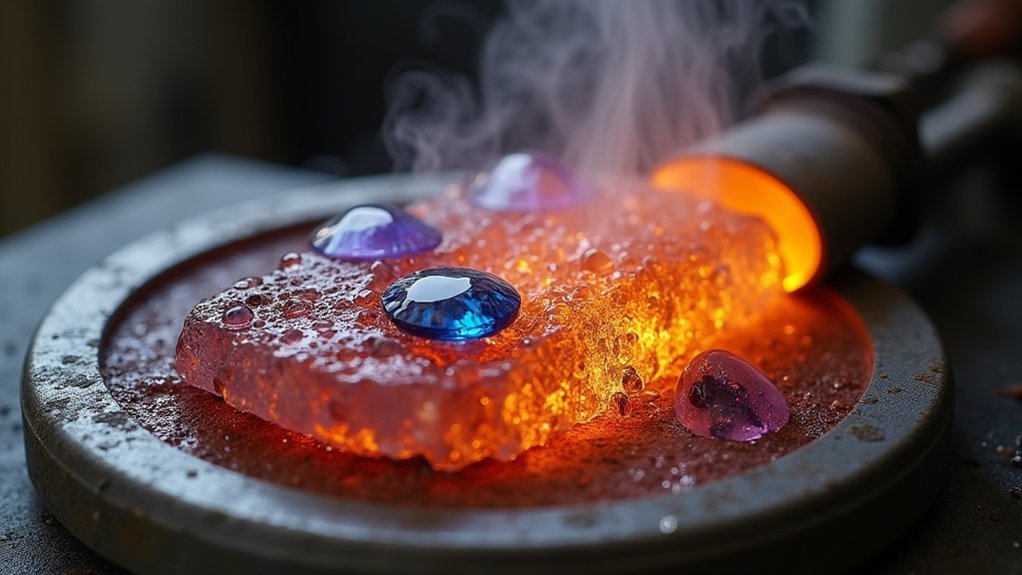
While traditional stone setting methods have dominated jewelry manufacturing for decades, stone-in-place casting offers compelling advantages that can transform your production economics.
You’ll virtually eliminate stone breakage, allowing you to use lower-grade gemstones without damage concerns. The casting process streamlines your workflow, reducing production time and eliminating extensive post-setting adjustments.
Your labor costs drop markedly since stone in place techniques require less skilled workers. You’ll pay wax setters $12-15 per hour versus traditional gold setters at $25-40 per hour.
Training time decreases substantially, getting new employees productive faster.
Essential Equipment and Materials for Gemstone Casting
You’ll need specialized investments like Solitaire investment to protect your gemstones during the burnout process.
Your casting setup must include precise temperature control systems since different stones require specific temperatures—diamonds need 1,050°F while lab-created opals require only 950°F.
These materials and equipment form the foundation for successful stone-in-place casting outcomes.
Specialized Investments and Alloys
Two essential components separate successful gemstone casting from conventional jewelry making: specialized investments and temperature-specific alloys.
You’ll need products like Solitaire investment (#Z14-303-BX) to protect your gemstones during burnout, preventing costly damage to valuable stones. These specialized investments work seamlessly with your existing casting equipment, making advanced casting techniques accessible without major equipment upgrades.
Your alloy selection proves equally vital. Use formulations designed for low-temperature efficiency—cast diamonds at 1,050°F and lab-created opals at 950°F.
Accurate temperature control prevents overheating damage, especially with lower melting point stones. You can incorporate protective additives into your casting metals for additional gemstone safeguarding.
This combination of specialized investments and temperature-specific alloys guarantees your stones maintain their integrity throughout the entire casting process.
Temperature Control Systems
Since conventional casting equipment works for gemstone casting, your success depends entirely on implementing precise temperature monitoring systems throughout the process.
You’ll need accurate temperature control to reach specific casting temperatures: 1,050°F for diamonds and 950°F for lab-created opals. These precise ranges prevent thermal damage that destroys valuable stones.
Your temperature control systems must continuously monitor fluctuations during casting to avoid overheating the metal.
Install multiple thermocouples at critical points throughout your equipment to maintain consistent readings. You can’t rely on guesswork when working with expensive gemstones.
Remember to let your flasks stabilize at room temperature for at least two hours post-investment before beginning.
This preparation step guarantees your temperature control systems can accurately regulate heat from the start, protecting your embedded stones from thermal shock.
Suitable Gemstones and Quality Requirements
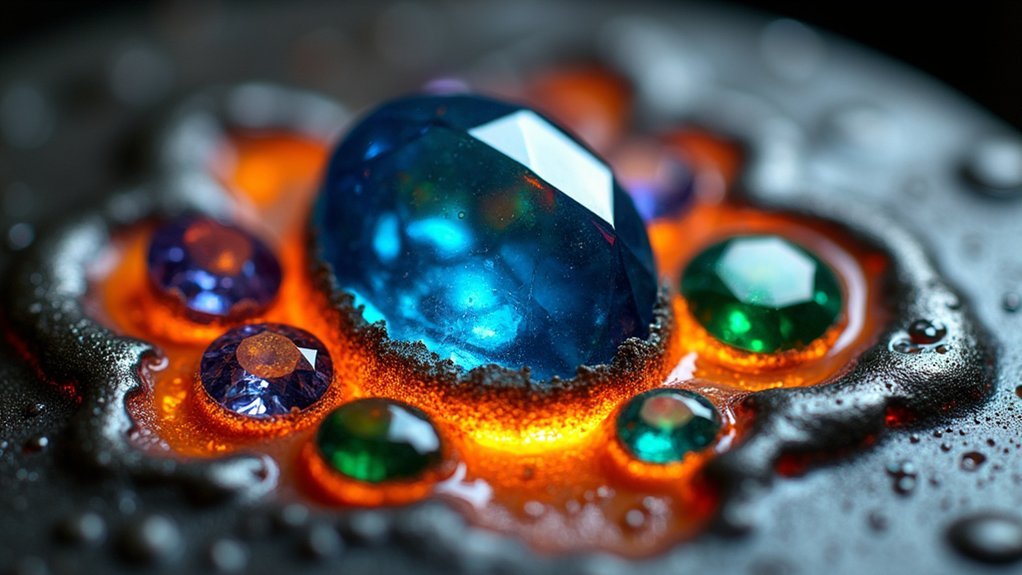
When you’re selecting gemstones for stone-in-place casting, you’ll need to focus on heat-resistant varieties that can withstand the intense temperatures of the casting process.
Diamond, sapphire, ruby, garnet, cubic zirconia, and laboratory-grown colored stones stand out as your best options due to their exceptional durability and casting compatibility.
However, you can’t simply choose any stone from these categories – the quality of your gemstone will make or break your casting success.
Heat-Resistant Stone Types
The success of stone-in-place casting depends heavily on selecting gemstones that can withstand high temperatures without sustaining damage.
When choosing heat-resistant stone types, you’ll find diamonds, sapphires, rubies, and garnets are your most reliable options. These stones can handle casting temperatures without compromising their structural integrity when properly managed.
You should set casting temperatures around 1,050°F for diamonds, while lab-created opals require lower temperatures of approximately 950°F.
Cubic zirconia and laboratory-grown colored stones also perform well under controlled heat conditions.
Monitor temperatures closely to prevent overheating—particularly keeping diamonds below 1,200°F.
You’ll achieve better results using lower quality stones like CZ’s, sapphires, rubies, and garnets, as they present minimal risk of damage during the casting process.
Quality Standards Matter
Excellence in gemstone selection directly determines your casting success, as even minor inclusions can transform a brilliant stone into a milky, frosty disappointment during the heat exposure process.
You’ll need flawless diamonds, sapphires, and rubies to achieve professional results in stone-in-place casting.
Your quality standards should prioritize these suitable options:
- Premium natural stones – Flawless diamonds, sapphires, rubies, and garnets that can withstand high-temperature exposure
- Laboratory-grown alternatives – Cubic zirconia and lab-created colored stones offering consistent quality and reliability
- Lower-grade options for wax patterns – When using stone-in-wax settings, you can safely experiment with broader gem selections since damage risk decreases considerably
Remember that thorough inspection of your wax patterns guarantees secure gemstone placement, directly impacting your final cast piece’s quality and overall success.
Model Preparation and Shrinkage Calculations
Before you begin the casting process, you’ll need to meticulously prepare your model and calculate shrinkage to guarantee stones fit securely in the final piece. Start by using liquid rubber with 0% shrinkage for mold-making to eliminate dimensional changes during curing. This precision prevents loose or misaligned stones in your finished casting.
Thoroughly inspect your wax pattern before setting it on the tree. Look for imperfections that could compromise stone placement and security.
For prong settings, you must create precise notches that’ll provide a snug fit, preventing stone movement during casting. Channel settings require carefully cut grooves to properly seat stones while accommodating thermal expansion and contraction.
Accurate shrinkage calculations from your rubber mold are absolutely essential for achieving professional results.
Wax Setting Techniques and Stone Placement
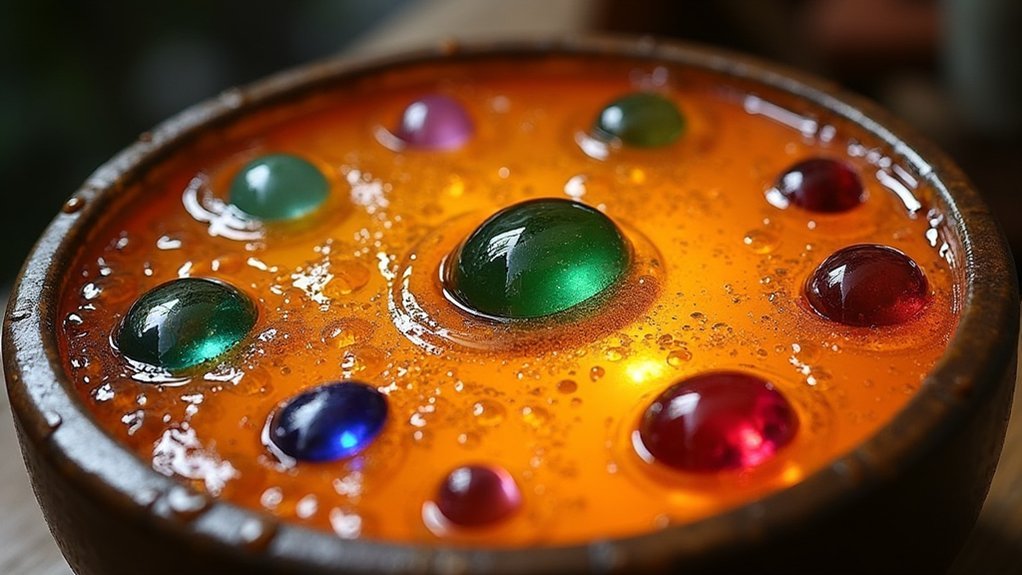
With your model prepared and shrinkage calculations complete, you’re ready to master the delicate art of placing gemstones in wax. The wax setting process requires precision and careful technique to guarantee your stones survive the casting journey intact.
Mastering gemstone placement in wax demands precision and careful technique to ensure stones survive the casting process intact.
Essential steps for successful stone placement include:
- Create proper settings – Notch prongs carefully and groove channels to secure stones while accommodating casting shrinkage.
- Apply gentle pressure – Press stones into position using minimal force to prevent breakage during the wax setting phase.
- Level and clean – Use heated wax tools to adjust stone heights for perfect alignment, then remove excess wax from stone surfaces.
Proper training in stone handling techniques guarantees ideal positioning and fit, resulting in a professional finished piece.
Temperature Control and Casting Metal Selection
Once you’ve secured your stones in the wax model, temperature control becomes the make-or-break factor in successful stone-in-place casting.
You’ll need precise temperatures: 1,050°F for diamonds and 950°F for lab-created opals. Your conventional casting equipment works fine, but you must monitor temperatures carefully to prevent overheating.
Choose special low-temperature alloys that’ll protect your gemstones while maintaining casting efficiency.
Keep both your flasks and melted metal at the coolest possible temperatures throughout the process. This minimizes damage risk to your precious stones.
Don’t forget proper investment protection—Solitaire investment (#Z14-303-BX) shields stones during burnout.
Your success depends on maintaining these controlled conditions consistently. One temperature spike can ruin expensive gemstones, so stay vigilant throughout the entire casting process.
Burnout Procedures and Flask Management
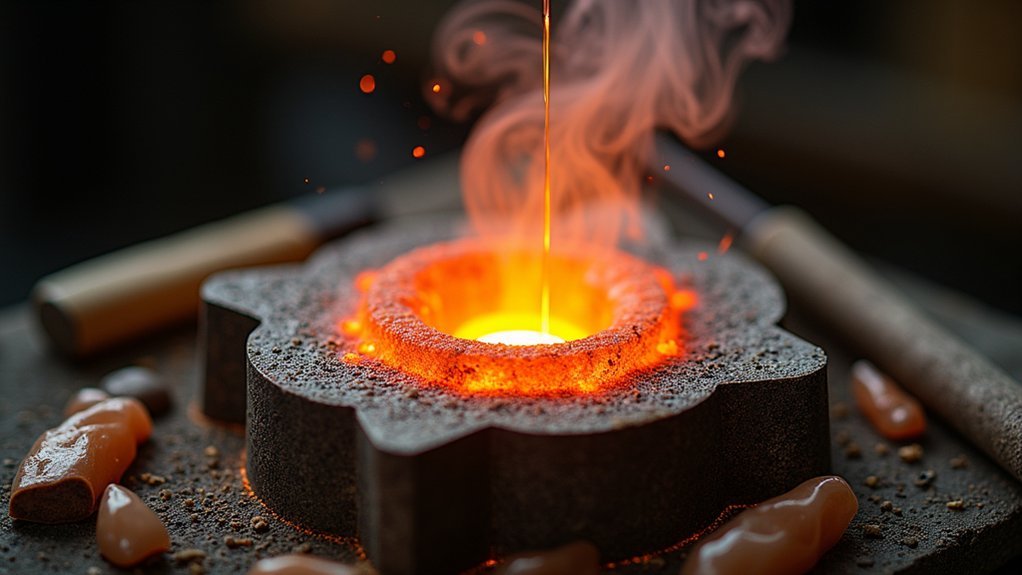
You’ll need to maintain strict temperature control protocols throughout the burnout cycle to protect your gemstones from thermal shock and damage.
Follow the specific temperature ramp-up schedule for stone-in-place casting, ensuring you don’t exceed the safe limits for your particular gemstone types.
After casting, you must allow your flasks to cool for at least two hours to reach a comfortable handling temperature before attempting investment removal.
Temperature Control Protocols
Although stone-in-place casting demands precision at every stage, temperature control protocols during burnout and flask management represent the most critical phase for preserving gemstone integrity.
Your success depends on maintaining specific temperatures that protect different stone types while guaranteeing complete wax elimination.
Follow these essential temperature control protocols:
- Set peak temperatures based on stone type – Use 1,050°F for diamonds and 950°F for lab-created opals to prevent damage while achieving proper burnout.
- Calibrate your burnout oven regularly – Confirm accurate temperature readings and maintain proper exhaust systems for consistent heat distribution.
- Cool flasks for two hours minimum – Allow flasks to reach comfortable handling temperature before removing investment to prevent thermal shock.
Proper temperature control protects your gemstones and guarantees successful casting results.
Flask Cooling Requirements
Flask cooling requirements demand your careful attention to prevent thermal shock that can crack gemstones or compromise your casting quality.
After completing your casting, flasks should be allowed to cool for at least two hours at room temperature before handling. This cooling period guarantees safe manipulation and protects delicate gemstones from temperature-induced damage.
Never quench your flasks in water during the cooling process, as rapid temperature changes create thermal shock that can fracture both stones and metal.
When you’re ready to begin removing the investment, immerse only the button of your casting tree in cold water for 5-10 minutes. This targeted cooling technique helps loosen investment material without exposing your gemstones to damaging temperature fluctuations that compromise the integrity of your stone-in-place casting.
Investment Removal and Cooling Methods
Once your casting cycle completes, proper cooling and investment removal become critical steps that’ll determine whether your embedded gemstones survive the process intact.
You’ll need patience during this phase—rushing can destroy hours of careful work and expensive stones.
Follow these essential steps for safe investment removal:
- Allow complete cooling – Wait at least two hours before handling flasks to prevent thermal shock damage to your gemstones.
- Use controlled removal techniques – Immerse the button in cold water for 5-10 minutes, then spray with investment removal solutions to loosen materials safely.
- Apply gentle force only – Tap around the flask with a rubber mallet rather than aggressive hammering.
Never quench hot flasks in water, as thermal shock will crack stones instantly, unlike rubber molds that handle temperature changes better.
Finishing Processes and Quality Control
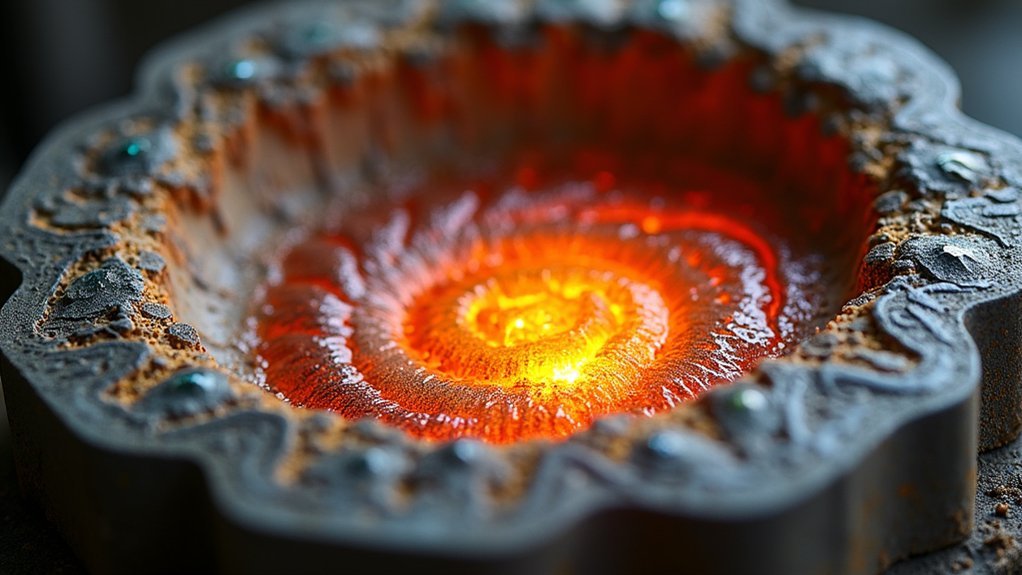
When your casting emerges from the investment, the finishing processes become your most critical quality control checkpoint.
You’ll need to avoid stripping and bombing processes entirely, as these aggressive techniques can damage stone settings and compromise your piece’s integrity. Instead, employ magnetic tumbling with needle-type media to brighten your castings without risking metal loss or harming delicate settings.
Conduct thorough quality checks on all cut-off pieces to identify loose stones requiring tightening before finalizing.
Remember that proper exhaust systems and temperature-calibrated burnout ovens maintain ideal casting conditions throughout the process.
Always confirm you’re using the coolest possible temperatures for both flasks and melted metal to prevent gemstone damage during finishing.
Common Challenges and Troubleshooting Solutions
Even with meticulous preparation, stone-in-place casting presents unique challenges that’ll test your technical skills and problem-solving abilities.
Common Issues and Solutions:
1. Stone Movement During Casting – Verify prongs are properly notched and channel settings have adequate grooves.
Double-check that stones fit snugly in your wax pattern before proceeding with investment.
2. Thermal Damage to Gems – Maintain precise temperatures: 1,050°F for diamonds and 950°F for lab-created opals.
Monitor your furnace carefully and calculate the shrinkage requirements when designing your pattern to accommodate proper stone placement.
3. Stone Loss During Investment Removal – Always use a strainer when cleaning castings and allow flasks to cool completely for at least two hours.
This prevents premature handling that could dislodge stones from their settings.
Frequently Asked Questions
Can You Melt and Cast Gemstones?
You can’t melt most gemstones for casting since they’d be destroyed. However, you can embed heat-resistant gems like diamonds, sapphires, and rubies into wax before casting metal around them.
How Do You Cast Gemstones in Place?
You’ll embed gemstones directly into wax patterns, creating settings slightly smaller than the stone’s girdle. Use a heated wax pen for secure placement, then cast using reduced pressure and proper burnout temperatures.
Can You Cast Moissanite in Place?
You can cast moissanite in place using stone-in-wax technique. Keep temperatures below 1,200°F to prevent damage. Use a heated wax pen for secure setting and guarantee proper handling throughout the casting process.
Can Cubic Zirconia Be Cast in Place?
You can cast cubic zirconia in place successfully. Use high-quality stones without inclusions, maintain casting temperature around 950°F, and apply gentle pressure when setting in wax for best results.
In Summary
You’ve now mastered the fundamentals of stone-in-place casting, from selecting suitable gemstones to managing the complex burnout process. You’ll save significant time and labor costs while achieving professional results that rival traditional setting methods. Remember to calculate shrinkage accurately, monitor your flask temperatures carefully, and don’t rush the cooling process. With practice, you’ll troubleshoot common issues quickly and consistently produce stunning cast jewelry with perfectly embedded stones.





Leave a Reply